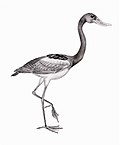| Anser | |
|---|---|
 | |
| Pair of greylag geese, Anser anser | |
| Scientific classification | |
| Kingdom: | Animalia |
| Phylum: | Chordata |
| Class: | Aves |
| Order: | Anseriformes |
| Family: | Anatidae |
| Subfamily: | Anserinae |
| Tribe: | Anserini Vigors 1825 |
| Genus: | Anser Brisson, 1760 |
| Type species | |
| Anas anser [1] | |
| Species | |
and see text | |
| Synonyms | |
Chen Boie, 1822 (but see text) Contents | |
Anser is a waterfowl genus that includes the grey geese and the white geese. It belongs to the true goose and swan subfamily of Anserinae under the family of Anatidae. [2] The genus has a Holarctic distribution, with at least one species breeding in any open, wet habitats in the subarctic and cool temperate regions of the Northern Hemisphere in summer. Some also breed farther south, reaching into warm temperate regions. They mostly migrate south in winter, typically to regions in the temperate zone between the January 0 °C (32 °F) and 5 °C (41 °F) isotherms.
The genus contains 11 living species. [2]














